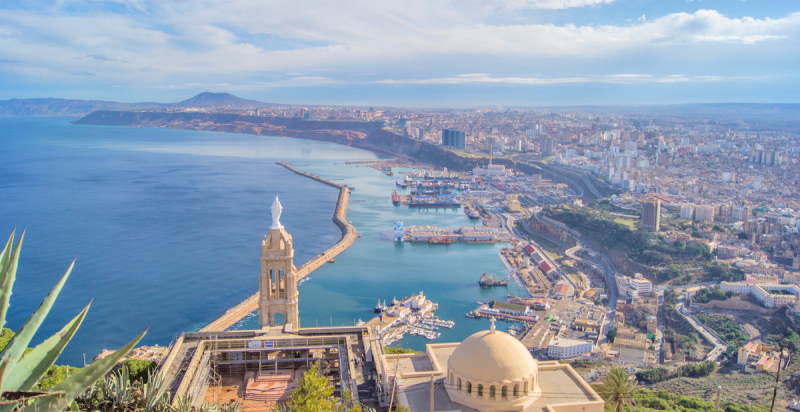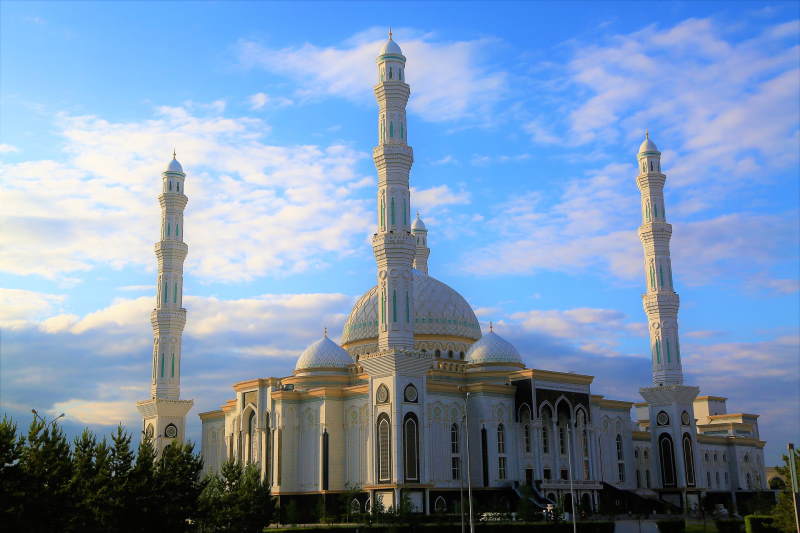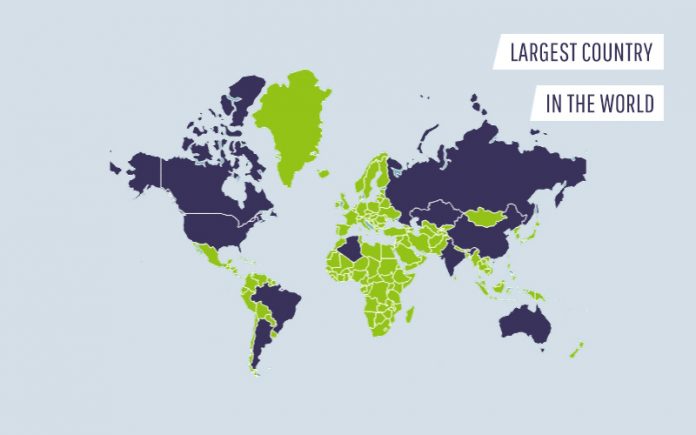No doubt Russia, with a surface area of 17,098,242 square kilometers across East Europe and Asia, is not surprisingly large. Following this, Canada and the United States completed the top three positions at 9,984,670 square kilometers and 9,857,348 square kilometers. China’s largest landmass in Asia is 9,706,961 square kilometers, while the Macau region of only 30 square kilometers on the south coast of China is the smallest. Algeria (2 381,741 km2) is Africa’s largest country, and the Mayotte archipelago (374 km2) is its smallest. While Russia is the largest country in Europe, France is 551,695 square kilometers, the largest in Europe.
So without any additional ado, let’s discuss The Top Ten Largest Countries in the World ranked by their Population and area.
10. Algeria

Algeria is the World’s 10th largest country in Africa. It is bordered on the west by Morocco, Western Sahara, and on the east by Tunisia and Libya, almost four times the size of Texas. The Mediterranean Sea is in the north, Mauritania, Mali, and Niger in the south. Almost completely uninhabited is its Sahara Region, which is 85% of the country. The highest point of the Sahara is Mount Tahat, 9,850 ft above sea level (3,000 m). With just 15.9 people per square kilometer (38/square miles), Algeria is one of the World’s least-populated countries. The capital of Algeria is Algiers, busy skyscrapers and apartment blocks, and its historical center. Oran, the Mediterranean Sea Port, near the border with Morocco, is Algeria’s second-largest city. Oran has developed into an important hub of music, art, and education less hectic than Algiers.
| Area: | 2,381,741 squares km |
| Continent: | Africa |
| Bordering Countries By Land: | Libya, Mali, Mauritania, Morocco, Niger, Tunisia |
9. Kazakhstan

Kazakhstan is Central Asia’s largest country and the World’s ninth-largest. It is north of the Central Asian republic and is bordered by northern Russia, eastern China, Kyrgyzstan, and south by Uzbekistan, the Caspian Sea, and western Turkmenistan. Kazakhstan is approximately four times Texas’ size. The area is mainly steppe with hilly plains and plateaus. The great mineral resources of Kazakhstan and the arable land have long been the envy of outsiders, and environmental and political problems have arisen from the resulting exploitation. The traditional Kazakh customs coexist uncomfortably with modern-day incursions. Kazakhstan signed an agreement in 2004 that would enable China to build an oil pipeline on the border with China.
| Area: | 2,724,900 squares km |
| Continent: | Asia / Europe |
| Bordering Countries By Land: | China, Kyrgyzstan, Russia, Turkmenistan, Uzbekistan |
8. Argentina

Argentina, a South American country that covers most of the continent’s southern part, is the eighth-largest country in the World. Second, in South America, Argentina is plain, rising from the Atlantic to the Chilean frontier and the towering Andes peaks. The highest peak in the World outside Asia is Aconcagua (22,834 ft). The border between Argentina and Bolivia is also on the north with Paraguay and east with Uruguay and Brazil. In the south of Argentina, there are fertile rolling pampas, rich in sheep and cattle grazing for the people’s livelihood. Buenos Aires, a self-contained town and is the capital and largest town of Argentina.
| Area: | 2,780,400 squares km |
| Continent: | South America |
| Bordering Countries By Land: | Bolivia, Brazil, Chile, Paraguay, Uruguay |
7. India

India is the 7th largest country in the World in the Southern Asian subcontinent. In the northeast, it borders on China. In the west, Pakistan is neighbors, in the north Nepal and Bhutan, and eastern Burma and Bangladesh. The Ganges, Indus, and Brahmaputra’s three large river systems are renowned in India, and they all rise in the Himalayas. As the years’ progress, the population of India continues to grow quite steadily. The population, in particular, ranked second after the population of China. India is expected to overpower China as the most populous country in the World around 2024. Like China, growth will stagnate in the latter half of the 21st century and will eventually decline.
| Area: | 3,287,263 squares km |
| Continent: | Asia |
| Bordering Countries By Land: | Bangladesh, Bhutan, China, Myanmar, Nepal, Pakistan |
6. Australia

Australia is the smallest continent and one of the largest countries in the World. It has the most important economic and cultural center of Sydney and Melbourne. The continent of Australia is approximately equal to the United States on Tasmania (excluding Alaska and Hawaii). Mountains extend from north to south along the east coast to their highest point at Kosciuszko Mountain (7,308 ft). A plateau of the desert, moving into barren hills near the west shore, occupies the continent’s western half. The Great Barrier Reef of Australia is located along the Northeast coast at approximately 2,245 mi (2,000 km) and ranked it on number six.
| Area: | 7,741,220 squares km |
| Continent: | Australia and Oceania |
| Bordering Countries By Land: | Indonesia, New Zealand, Solomon Islands, Papua New Guinea |
5. Brazil

Brazil is the fifth biggest nation in the World and has one-third of the population of Latin America. Although its capital, Brasília, is far inside and more migrants move inland. Many of the inhabitants of Brazil live along the eastern seaboard. Brazil is the continent and covers almost half of South America. It extends north-south 2,965 miles (4,772 miles) and East-West 2,691 mi (4,331 km) to Chile and Ecuador. It borders every nation on this continent. The Amazon can be safely navigated by sea steamers upstream to Iquitos, Peru. Paraguay, Uruguay, and Paran Rivers are also draining from southern Brazil. The landscape of Brazil is huge and complex and is surrounded by interspersed rivers, wetlands, mountains, and plateaus that cross the borders of the countries and regions.
| Area: | 8,515,770 squares km |
| Continent: | South America |
| Bordering Countries By Land: | Argentina, Bolivia, Colombia, France (French Guiana), Guyana, Paraguay, Peru, Suriname, Uruguay, Venezuela |
4. China

China is the largest in all Asian countries and comprises the World’s largest population. It is only surpassed by Russia and Canada, and the United States among the World’s largest countries. The Tien Shan, the Kunlun chain, and the Trans Himalayas are its main ranges. Tibet is located in the southwest and was annexed by China in 1950. Proper China comprises three major river systems: the Yellow River (Huang He). The Yangtze River (Chang Jiang) is the World’s third longest river and the Pearl River. China is classified by the World as being the top middle-industry country and has drawn millions of its population out of poverty by its rapid growth over the decades.
| Area: | 9,596,961 squares km |
| Continent: | Asia |
| Bordering Countries By Land: | Afghanistan, Bhutan, India, Kazakhstan, Kyrgyzstan, Laos, Mongolia, Myanmar, Nepal, North Korea, Pakistan, Russia, Tajikistan, Vietnam |
3. United States

The United States has a slightly bigger area of land than Canada’s neighbor. Its main pattern of landforms and mineral resources are two great sets of elements for the US. Although these elements are not entirely separate, each produces such patterns that it is the biggest economic power globally, measured by gross domestic product (GDP). The US remains the most important single factor in world trade because of the sheer size of its economy despite its relative economic auto sufficiency in many fields. California, which is estimated at just over 39.5 million people, is the largest state by population in the United States. It was the 36th most populous country on earth, slightly more than Iraq and Poland if California were a country.
| Area: | 9,857,348 squares km |
| Continent: | North America |
| Bordering Countries By Land: | Canada, Mexico |
2. Canada

Canada is the second-largest nation in the World by area and Population. If we included water bodies like the Great Lakes, that would be correct, but it is just behind China and the United States by surface area. The South St. Lawrence Plain of Quebec and Ontario, and the Southern and Saskatchewan, and most of Alberta inland continental Plain are the major elements of Canada. West to the Pacific, parallel mountain areas, including the Rockies, cover most British Columbia, the Yukon, and Western Alberta. The Pacific coastline is lined with channels and fjords. Mount Logan (19,830) is located in the Yukon And is the highest point in Canada. The Mackenzie and St. Lawrence are the two main river systems.
| Area: | 9,984,670 squares km |
| Continent: | North America |
| Bordering Countries By Land: | United States |
1. Russia

Russia covers two continents comfortably and covers approximately 11% of the total landmass of the Earth. The statistics and the facts give us an idea of how large this place is. The Russian Federation is the largest of the 21 independent Commonwealth republics. It spreads from the Baltic Sea to the Pacific Ocean in eastern Europe and from the Arctic Ocean to the Black Sea and the Caucasus in the south, covering much of northern Asia. Russia is the largest land-based country globally, but it is unfavorable concerning the World’s major maritime lanes. Russia contains the highest peak in Europe, Mount Elbrus, and the deepest lake in the World, Lake Baikal. It is estimated that Baikal Lake has a fifth of the freshwater worldwide. Russia’s an excellent country and covers almost twice the territory of Canada, which is by far the World’s largest country. The longest river in Europe, the Volga, and their largest lake, Ladoga, is also in Russia.
| Area: | 17,098,242 squares km |
| Continent: | Asia / Europe |
| Bordering Countries By Land: | Azerbaijan, Belarus, China, Estonia, Finland, Georgia, Kazakhstan, Latvia, Lithuania, Mongolia, North Korea, Norway, Poland, Ukraine |
So, these are all about The Ten Largest Countries along with their area and Population in 2021! If you want to take a glimpse of all the Countries ranking, then have a look below:
| Rank | Country | Area(sq km) | Population(2021) |
| 1 | Russia | 17,098,242 | 145,934,462 |
| 2 | Canada | 9,984,242 | 37,742,154 |
| 3 | China | 9,706,961 | 1,443,903,325 |
| 4 | United State | 9,372,610 | 331,002,651 |
| 5 | Brazil | 8,515,767 | 213,798,900 |
| 6 | Australia | 7,692,024 | 25,740,587 |
| 7 | India | 3,287,590 | 1,380,004,385 |
| 8 | Argentina | 2,780,400 | 45,195,774 |
| 9 | Kazakhstan | 2,724,900 | 18,897,898 |
| 10 | Alferia | 2,381.741 | 43,851,044 |
| 11 | Dr Congo | 2,344,858 | 89,561,403 |
| 12 | Greenland | 2,166,086 | 56,225 |
| 13 | Saudi Arabia | 2,149,690 | 34,813,871 |
| 14 | Mexico | 1,964,375 | 128,932,753 |
| 15 | Indonesia | 1,904,569 | 273,523,615 |
| 16 | Sudan | 1,886,068 | 43,849,260 |
| 17 | Libya | 1,759,540 | 6,871,292 |
| 18 | Iran | 1,648,195 | 83,992,949 |
| 19 | Mongolia | 1,564,110 | 3,278,290 |
| 20 | Peru | 1,285,216 | 32,971,854 |
| 21 | Chad | 1,284,000 | 16,425,864 |
| 22 | Niger | 1,267,000 | 24,917,337 |
| 23 | Angola | 1,246,700 | 33,697,207 |
| 24 | Mali | 1,240,192 | 20,725,347 |
| 25 | South Africa | 1,221,037 | 59,920,897 |
| 26 | Colombia | 1,141,748 | 51,325,750 |
| 27 | Ethiopia | 1,104,300 | 117,268,380 |
| 28 | Bolivia | 1,098,591 | 11,673,021 |
| 29 | Mauritania | 1,030,700 | 4,649,658 |
| 30 | Egypt | 1,002,450 | 102,334,404 |
If you are still curious to find the data of the smallest ten countries along with their area and Population, then here you can go!
| Rank | Country | Area(sq km) | Population(2021) |
| 1 | Vatican City | 0.44 | 825 |
| 2 | Monaco | 1.95 | 38,964 |
| 3 | Pitcairn Island | 5 | 50 |
| 4 | Gibraltar | 6 | 33,691 |
| 5 | Tokelau | 12 | 1411 |
| 6 | Nauru | 21 | 10,824 |
| 7 | Tuvalu | 26 | 11,792 |
| 8 | Norfolk Island | 36 | 2169 |
| 9 | Bermuda | 53 | 62,090 |
| 10 | San Marino | 61 | 806 |
Conclusion!
After reviewing this list of the ten world’s largest (surface-sized) countries, it has been concluded that Russia is at the top with a surface area of 17,098,242 km2, followed by Canada with 9,984,670 sq km and population. But also, the borders of the world change which might occur some changes in future on this list of top ten biggest countries in the World by area and Population.
